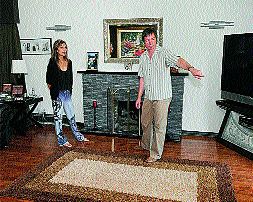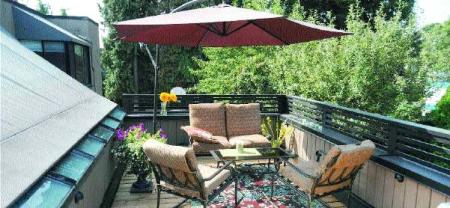Adding items doesn’t hurt either, ‘home stagers’ advise
Kim Pemberton
Sun

The master-bedroom treatment suggested by Ron Sowden replaced the floral bedspread with a tan-coloured bed set and draped a loveseat in slip covers. Shown in the master-bedroom photo are homeowner Abbe Gates and stager Sowden. Shown in in daughter Sadie’s bedroom, are Sowden, Sadie and Abbe. Photograph by : Stuart Davis, Vancouver Sun

The master-bedroom treatment suggested by Ron Sowden replaced the floral bedspread with a tan-coloured bed set and draped a loveseat in slip covers. Shown in the master-bedroom photo are homeowner Abbe Gates and stager Sowden. Shown in in daughter Sadie’s bedroom, are Sowden, Sadie and Abbe. Photograph by : Stuart Davis, Vancouver Sun

Abbe and Gary Gates Photograph by : Stuart Davis, Vancouver Sun

Abbe and Gary Gates Photograph by : Stuart Davis, Vancouver Sun

Abbe and Gary Gates Photograph by : Stuart Davis, Vancouver Sun

Abbe and Gary Gates Photograph by : Stuart Davis, Vancouver Sun

Abbe and Gary Gates Photograph by : Stuart Davis, Vancouver Sun
When Abbe and Gary Gates put their Vancouver home on the market, they knew they needed to make some cosmetic changes to make sure their residence stood out.
They cleared out the clutter and hired cleaners. And then they called in a home-staging consultant– veteran film set designer Ron Sowden, one of the principals of Dekora, a Vancouver-based home and event staging company.
After Sowden visited, the Gates learned more could still be done in their bid to sell their 5,586-square-foot home on Southwest Marine Drive, listed at $1.749 million. One of the first suggestions was to eliminate all of the family photos, except for a black and white family photo that comes across more like “art” says Sowden.
As Sowden explains, the objective is to take the personal out of the space and neutralize colour choices so potential buyers aren’t distracted.
“If you love colour and you are not selling your home — go for it. But if you are trying to sell, the buyer has to digest that and it can get in the way. That’s why we’re always pushing for neutrals. It’s not that we want a blander world. It’s just safer and easier for the buyer to project their decorating tastes onto an open space,” says Sowden.
“You have to stop thinking of it as your home and start viewing it as a product.”
Those interested in learning more about how to change the way they look at their homes may already have picked up on The Stagers, a new half-hour reality show, shot in Vancouver, that follows local designers working for Dekora as they transform houses for sale.
The show began airing in July on Home and Garden Television in both Canada and the U.S., making it the first time a Vancouver-based series was picked up by the network to air in both countries simultaneously. Usually, HGTV pilots a Canadian show first in Canada to see if it will be a hit with viewers before going to the larger market south of the border.
The show appeals not only to sellers wanting to learn how to get the edge over the competition in a softening resale market, but also to homeowners simply interested in home improvement tips.
“We’ve been thinking about doing a show for years,” says John Carter, one of the Dekora founders. “Then out of the blue we get an e-mail from a Vancouver film company, Paperny Films.
”Their story development division wanted to talk and everything clicked. They produced it and we would be the focus. I haven’t seen anything like it on TV. It’s more real world. Every job is a real job and there is no host, per se. The designers featured are not hosting. They are just doing their job.”
Home staging, where a home is presented in the best possible light for resale, is a trend that has been catching on for years, with about a dozen other home-stage businesses now in operation in the Lower Mainland.
When Dekora first started in 2003, by Carter, Sowden, and businesswoman Barbara Rae, it was the only company in town using Sowden’s garage to store furniture and accessories.
Since then, the company has expanded to 50 staff members and 20 designers on contract, and has long since moved out of the garage and into a 10,000-square-foot warehouse that houses more than $1 million worth of inventory. Dekora also recently expanded to Calgary and is also staging “events.”
“The big reason we are growing is home-staging works,” says Carter. “This business is all about common sense. If you are going to sell your home it becomes a product and a product has to look good.”
Thirteen episodes of The Stagers have been shot, with no word yet on whether a second season will be ordered. All of the episodes feature homes that require major changes, costing anywhere from $5,000 to $10,000 to stage. As Carter notes, the homes featured on the television show have undergone dramatic changes. “Moving a couch doesn’t sustain an episode,” he points out.
And while that price tag sounds steep, Carter adds that it’s value for money, considering a higher percentage of staged homes sell quickly and for top dollar.
Carter says a study by the National Association of Realtors found staged homes generally sell seven to 11 per cent higher than non-staged homes, and in under half the time.
“It’s difficult to quantify the return. For instance, if the house was listed at $750,000, was staged for $6,000 and sold for $740,000 people assume the seller lost money. But was the selling price realistic? If the staging wasn’t done, would they have even received the offer?”
Carter says what he knows for certain is that staging makes sense, especially considering that your home is often your No. 1 investment.
“When you’re selling your vehicle most people know it’s important to detail it. You wouldn’t think twice of spending $150 to detail a $10,000 car. Why not spend $5,000 for a $500,000 house?”
But for homeowners uncertain or unable to take the financial plunge, Dekora also does consultations and leaves it up to the homeowner as to whether they want to implement any of the ideas offered.
The company charges $150 for a condo consultation and $250 for detached homes. For consultations, the designer walks through a home, room by room, making suggestions about what the homeowner can do to improve its chances for resale. Typically, they spend two to three hours with the client and provide a detailed written checklist, says Sowden.
When the Gates placed their house on the market, their realtor, Erick Malkin of Sutton Realty, warned them that competition is definitely tougher this year compared to last year.
Last year, says Malkin, a 10-block area nearby had eight houses for sale in July, compared to 40 houses in the same 10-block radius this year.
“You can never go wrong staging a house. Most buyers looking at homes lack imagination of what could go where and colours,” says Malkin.
Sowden had no shortage of tips for the Gates.
With the pool and outdoor entertaining area, he suggested they get rid of the “tired” plastic deck chairs and invest in black, all-weather rattan furniture that would complement both the home’s exterior colour and the large flower boxes they already have in place.
In the living room, Sowden suggested they make it appear more “formal”, rather than appearing like a rec room — especially considering that there is already a large rec room downstairs. They were advised to remove the oversized television and rearrange the couches so that the newly re-faced fireplace would become the focal point.
Another suggestion was to get rid of the floral bedspread and matching floral lampshades in the master bedroom and to add slip covers to the love seat in the room’s reading nook.
In the case of toning down the bed duvet it, turns out Abbe didn’t have to go shopping. She already owned a tan coloured bed set that would contrast with the room’s darker wall colour.
“Most people don’t see their homes through an objective lens. Often it’s all about repositioning,” he says. “You want the product to stand out.”
Sowden should know, considering he has 15 years in the film industry working on sets and five years as chief designer and CEO with Dekora.
Many of the designers featured on The Stagers, like Sowden, have a film industry background.
As Carter notes “it’s a similar industry. You have to move fast, be careful with budgets and roll up your sleeves to get things done.”
Designer Dina Holmes, who has been working eight years in set design, recently did a comprehensive home staging job for Dekora of a $3.2-million Vancouver home.
She was lucky with this particular home because the seller had recently renovated the home and many of the rooms were already empty.
Often, she says, stagers are asked to work with some of the homeowners’ existing pieces of furniture that aren’t ideal.
Still, the newly renovated home wasn’t without problem furniture. In this case, the furniture the family did have was traditional in style and didn’t fit in the context of their contemporary modern home.
“The furniture definitely didn’t go with the house, big puffy green leather couches from the Brick and mismatched traditional art,” says Holmes.
On the day the Vancouver Sun visited the home, a Dekora truck was being unloaded with sleek modern furnishings and accessories. The walls were already a neutral colour so Dekora didn’t have to worry about any major cosmetic changes.
For this 4,600-square-foot home, Holmes was staging the family room — it once housed the green couches — into an executive office/television room, as well as the open concept living/dining room, kitchen, three upstairs bedrooms and four bathrooms.
On her first visit to the home, Holmes took photos, then “ran like mad to Dekora” to select furniture, lighting, rugs and accessories.
“It’s always a scramble because there are other stagers and we all want the good lamps, the good vases. Often we’ll be running back and forth and switching things out.”
Getting the home into show house condition took Holmes and her assistant took four days. The first two were preparation days and the final two days were staging.
Her aim was to make the house “feel peaceful” and “inviting” and to stage it to the target market. In this case, that was a family, so one of the bedrooms was designed for a young girl and the room off the kitchen was turned into a “family room.”
The Stagers is on HGTV Tuesdays at 7 and 11 p.m.
© The Vancouver Sun 2008
